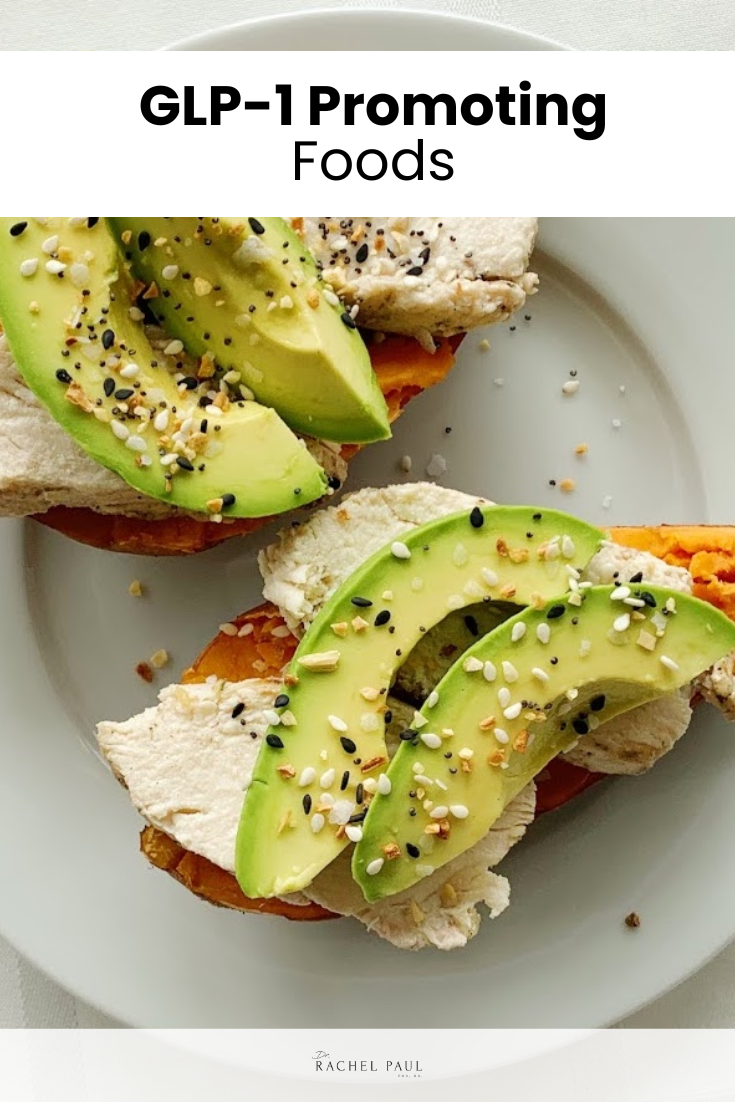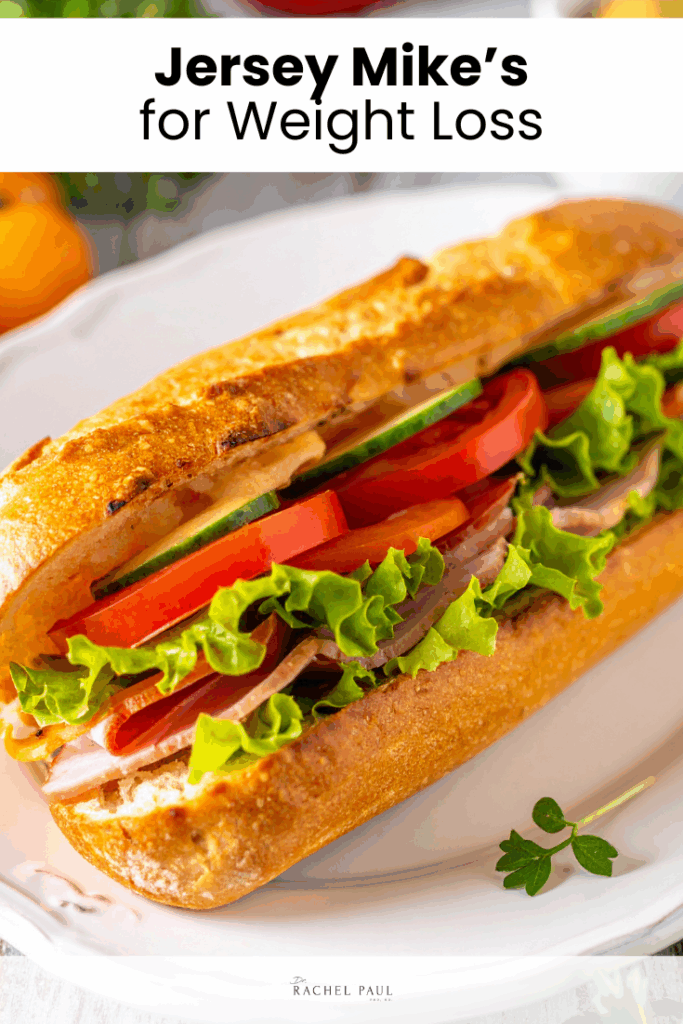If you’ve been wondering what is GLP-1 and how it relates to weight loss, you’re not alone. GLP-1 is a naturally occurring hormone that plays a major role in appetite regulation, blood sugar control, and fullness. It’s also the target of popular weight loss medications like Ozempic and Wegovy.
In this post, we’ll break down exactly what GLP-1 does, how food can help support it naturally, and what to know if you’re thinking about taking a GLP-1 medication.
What Is GLP-1 and Can Food Help You Boost It Naturally?
GLP-1 (glucagon-like peptide-1) is a hormone your body naturally produces to help regulate blood sugar and appetite.
It plays a major role in:
- Slowing how quickly food leaves your stomach
- Helping you feel full longer
- Reducing blood sugar spikes
- Supporting fat loss when managed effectively
This hormone is one reason high-protein, whole food diets can feel so satisfying – they naturally help your body release GLP-1.
Thinking About Taking a GLP-1 Medication?
Medications like Ozempic, Wegovy, Mounjaro, or Zepbound are synthetic versions of GLP-1 or similar hormones.
They’re often prescribed for type 2 diabetes and weight loss. These medications mimic your body’s natural GLP-1, helping reduce hunger and regulate blood sugar.
Pros:
- Helps regulate appetite
- Lowers blood sugar
- Can result in significant weight loss
Cons:
- Can lead to muscle loss if protein isn’t prioritized
- Often regain weight after stopping
- Can cause digestive issues, nausea, or vomiting
- Long-term effects are still being studied
- Often expensive and not always covered by insurance
Can Foods Naturally Promote GLP-1?
Yes, your food choices can help support natural GLP-1 release.
Protein, fat, fiber, and fermented foods can all help your body regulate hunger and blood sugar, especially when paired with healthy habits like strength training and consistent meals.
Foods That Support GLP-1
Here are the three key nutrition strategies that naturally support GLP-1:
1. Protein-Rich Foods
Protein slows digestion, helps control appetite, and directly supports GLP-1 secretion through gut stimulation.
Examples:
- Salmon
- Eggs
- Greek yogurt
- Ground beef
- Tuna
- Rotisserie chicken
2. Healthy Fats
Fats delay gastric emptying (how fast food leaves the stomach) and help release other satiety hormones like CCK, extending GLP-1’s effects.
Examples:
- Avocados
- Olive oil
- Cheese
- Butter
- Full-fat dairy
- Tallow
3. Fiber & Fermented Foods
Gut-friendly fibers and fermented foods increase GLP-1 activity by feeding beneficial bacteria and supporting blood sugar regulation.
Examples:
- Sauerkraut
- Yogurt
- Beans
- Raspberries
- Blackberries
Natural GLP-1 Hacks
Some natural compounds and food combinations have also been shown to support GLP-1 release or appetite regulation.
Top GLP-1 Boosters:
- Yerba mate
- Full-fat dairy
- Ginger
- Coffee
- Green tea
- Allulose (a rare sugar)
GLP-1 Promoting Meal Plans
Here are two sample meal plans built around foods that support natural GLP-1 production – using real, satisfying ingredients.
Day 1 Meal Plan
- Breakfast: Eggs, smoked salmon, avocado, butter
- Lunch: Turkey “pepper-wich”
- Snack: Avocado halves with salmon salad
- Dinner: Spaghetti squash caprese with chicken
Day 2 Meal Plan
- Breakfast: Sweet potato, avocado, shredded chicken
- Lunch: Roast beef and boiled eggs
- Snack: Cream cheese cucumber bites
- Dinner: Ground beef taco skillet with avocado
Already Taking a GLP-1 Medication? Here’s How to Support Your Body
Even if you’re using a GLP-1 medication, the habits you build matter.
To protect your metabolism and muscles, make sure you:
- Eat at least 100–130g of protein daily
- Strength train 2–4x/week
- Stay hydrated and monitor electrolytes
- Prioritize real food over ultra-processed options
- Track muscle loss and body comp, not just scale weight
- Focus on building sustainable routines
Whether you’re using GLP-1 medication or not, your food choices matter.
The goal is never perfection – it’s about finding strategies that make you feel good, keep you full, and help you stay consistent. That’s where real progress comes from.
Need Extra Support?
Inside Best Body, you’ll get:
- Dietitian-approved weight loss plans
- Meal inspiration that supports hormones like GLP-1
- Coaching to help you stay consistent
- 2,000+ high-protein, easy meals
- A plan that works with your lifestyle
Citations
- Holst, J. J. (2007). The physiology of glucagon-like peptide-1. Physiological Reviews, 87(4), 1409–1439. https://doi.org/10.1152/physrev.00034.2006
- Zheng, H., Wang, Y., Zhu, J., Yao, Y., Zhang, C., & Gao, Q. (2024). Glucagon-like peptide-1 receptor: mechanisms and advances in therapy. Signal Transduction and Targeted Therapy, 9(1), 234. https://doi.org/10.1038/s41392-024-01637-w
- Drucker, D. J., Philippe, J., Mojsov, S., Chick, W. L., & Habener, J. F. (1987). Glucagon-like peptide I stimulates insulin gene expression and increases cyclic AMP levels in a rat islet cell line. Proceedings of the National Academy of Sciences, 84(10), 3434–3438. https://doi.org/10.1073/pnas.84.10.3434
- Hall, K. D., Ayuketah, A., Brychta, R., et al. (2019). Ultra-processed diets cause excess calorie intake and weight gain: An inpatient randomized controlled trial of ad libitum food intake. Cell Metabolism, 30(1), 67–77. https://doi.org/10.1016/j.cmet.2019.05.008
- Westerterp-Plantenga, M. S., Nieuwenhuizen, A., Tome, D., Soenen, S., & Westerterp, K. R. (2009). Dietary protein, weight loss, and weight maintenance. Annual Review of Nutrition, 29, 21–41. https://doi.org/10.1146/annurev-nutr-080508-141056
- Chaput, J. P., Klingenberg, L., Astrup, A., & Sjödin, A. M. (2011). Modern sedentary activities promote overconsumption of food in our current obesogenic environment. Obesity Reviews, 12(5), e12–e20. https://doi.org/10.1111/j.1467-789X.2010.00772.x
- Czeisler, C. A., & Gooley, J. J. (2007). Sleep and circadian rhythms in humans. Cold Spring Harbor Symposia on Quantitative Biology, 72, 579–597. https://doi.org/10.1101/sqb.2007.72.064
- Chrousos, G. P. (2009). Stress and disorders of the stress system. Nature Reviews Endocrinology, 5(7), 374–381. https://doi.org/10.1038/nrendo.2009.106
- Novo Nordisk. (2024). Wegovy® (semaglutide) injection for subcutaneous use: Full prescribing information. https://www.novo-pi.com/wegovy.pdf
- Novo Nordisk. (2024). Ozempic® (semaglutide) injection: Full prescribing information. https://www.novo-pi.com/ozempic.pdf
- Eli Lilly and Company. (2024). Mounjaro® (tirzepatide) injection: Full prescribing information. https://www.accessdata.fda.gov/drugsatfda_docs/label/2022/215866s000lbl.pdf
- Frias, J. P., Davies, M. J., Rosenstock, J., et al. (2020). Tirzepatide versus semaglutide once weekly in patients with type 2 diabetes. The New England Journal of Medicine, 385(6), 503–515. https://doi.org/10.1056/NEJMoa2107519
- Jastreboff, A. M., Aronne, L. J., Ahmad, N. N., et al. (2022). Tirzepatide once weekly for the treatment of obesity. The New England Journal of Medicine, 387(3), 205–216. https://doi.org/10.1056/NEJMoa2206038
- Ryan, D. H., Yockey, S. R., & Apovian, C. M. (2021). Anti-obesity medications and weight loss. Nature Reviews Endocrinology, 17(12), 757–769. https://doi.org/10.1038/s41574-021-00547-8
- Moran, T. H., & Dailey, M. J. (2011). Intestinal feedback signaling and satiety. Physiology & Behavior, 105(1), 77–81. https://doi.org/10.1016/j.physbeh.2011.02.017
- Rehfeld, J. F. (2004). A centenary of gastrointestinal endocrinology. Hormone and Metabolic Research, 36(11–12), 735–741. https://doi.org/10.1055/s-2004-826177
- Tolhurst, G., Heffron, H., Lam, Y. S., et al. (2012). Short-chain fatty acids stimulate the release of gut hormones via the G-protein-coupled receptor FFAR2. American Journal of Physiology-Endocrinology and Metabolism, 302(4), E541–E549. https://doi.org/10.1152/ajpendo.00574.2011
- Lomenick, J. P., Melguizo, M. S., Mitchell, S. L., & Summar, M. L. (2009). Effects of low carbohydrate vs low fat ketogenic diet on appetite and hunger hormones. Journal of Pediatric Endocrinology and Metabolism, 22(11), 1053–1061. https://doi.org/10.1515/jpem.2009.22.11.1053
- Thomas, D. E., Elliott, E. J., & Baur, L. (2007). Low glycaemic index or low glycaemic load diets for overweight and obesity. The Cochrane Database of Systematic Reviews, 3, CD005105. https://doi.org/10.1002/14651858.CD005105.pub2
- Aziz, A. A., Kenney, L. S., Goulet, B., & Abdel-Aal, E. M. (2009). Glycemic index, glycemic load, and dietary fiber intake of foods commonly consumed in Canada. Journal of the American College of Nutrition, 28(6), 723–732. https://doi.org/10.1080/07315724.2009.10719791
- Slavin, J. L. (2013). Fiber and prebiotics: Mechanisms and health benefits. Nutrients, 5(4), 1417–1435. https://doi.org/10.3390/nu5041417
- Christensen, L., Roager, H. M., Astrup, A., & Hjorth, M. F. (2020). Microbial enterotypes and weight loss: results from a randomized controlled trial. Gut Microbes, 11(4), 855–866. https://doi.org/10.1080/19490976.2019.1701351
- Smith, M. I., Yatsunenko, T., Manary, M. J., et al. (2013). Gut microbiomes of Malawian twin pairs discordant for kwashiorkor. Science, 339(6119), 548–554. https://doi.org/10.1126/science.1229000
- Sonnenburg, E. D., & Sonnenburg, J. L. (2014). Starving our microbial self: The deleterious consequences of a diet deficient in microbiota-accessible carbohydrates. Cell Metabolism, 20(5), 779–786. https://doi.org/10.1016/j.cmet.2014.07.003
- Zmora, N., Suez, J., & Elinav, E. (2019). You are what you eat: Diet, health and the gut microbiota. Nature Reviews Gastroenterology & Hepatology, 16(1), 35–56. https://doi.org/10.1038/s41575-018-0061-2
- Arcari, D. P., Bartchewsky, W. Jr., et al. (2011). Anti-inflammatory effects of yerba mate extract on colon carcinogenesis. Nutrition, 27(3), 327–333. https://doi.org/10.1016/j.nut.2010.02.003
- Bracesco, N., Sánchez, A. G., Contreras, V., Menini, T., & Gugliucci, A. (2011). Recent advances on Ilex paraguariensis research: Minireview. Journal of Ethnopharmacology, 136(3), 378–384. https://doi.org/10.1016/j.jep.2011.05.003
- Hursel, R., Viechtbauer, W., & Westerterp-Plantenga, M. S. (2009). The effects of green tea on weight loss and weight maintenance: A meta-analysis. International Journal of Obesity, 33(9), 956–961. https://doi.org/10.1038/ijo.2009.135
- Mao, Q. Q., Xu, X. Y., Cao, S. Y., et al. (2019). Bioactive compounds and bioactivities of ginger (Zingiber officinale Roscoe). Food & Function, 10(8), 4371–4393. https://doi.org/10.1039/C9FO00866B
- Van Dam, R. M., & Hu, F. B. (2005). Coffee consumption and risk of type 2 diabetes. Journal of the American Medical Association, 294(1), 97–104. https://doi.org/10.1001/jama.294.1.97
- Wedick, N. M., Brennan, A. M., Sun, Q., et al. (2011). Effects of caffeinated and decaffeinated coffee on biological risk factors for type 2 diabetes: A randomized controlled trial. Nutrition Journal, 10(1), 93. https://doi.org/10.1186/1475-2891-10-93
- Noronha, M., Souza, M. R., et al. (2022). Allulose as a functional sugar substitute: Current status and future perspectives. Food Research International, 152, 110891. https://doi.org/10.1016/j.foodres.2021.110891
- Iida, T., Yamaguchi, T., et al. (2010). Effects of allulose on blood glucose and insulin levels in normal and diabetic rats. Bioscience, Biotechnology, and Biochemistry, 74(4), 641–645. https://doi.org/10.1271/bbb.90999
- Han, Y., et al. (2016). Allulose reduces body fat and improves lipid profile in humans. Journal of Functional Foods, 22, 327–334. https://doi.org/10.1016/j.jff.2016.01.034
- Hayashi, N., Iida, T., et al. (2010). Rare sugars suppress fat accumulation in mice. Nutrition, 26(6), 641–648. https://doi.org/10.1016/j.nut.2009.07.007
- Wadden, T. A., et al. (2021). Lifestyle intervention in patients with obesity and type 2 diabetes. The New England Journal of Medicine, 384(2), 121–131. https://doi.org/10.1056/NEJMoa2023961
- Drucker, D. J. (2018). Mechanisms of action and therapeutic application of glucagon-like peptide-1. Cell Metabolism, 27(4), 740–756. https://doi.org/10.1016/j.cmet.2018.03.001
- Wilding, J. P., Batterham, R. L., et al. (2021). Once-weekly semaglutide in adults with overweight or obesity. The New England Journal of Medicine, 384(11), 989–1002. https://doi.org/10.1056/NEJMoa2032183
- Heymsfield, S. B., & Wadden, T. A. (2017). Mechanisms, pathophysiology, and management of obesity. The New England Journal of Medicine, 376(3), 254–266. https://doi.org/10.1056/NEJMra1514009
- Mullins, R., & Chandalia, M. (2020). Sarcopenia and the effects of obesity and diabetes. Endocrinology and Metabolism Clinics, 49(2), 233–247. https://doi.org/10.1016/j.ecl.2020.03.007
- Perreault, L., et al. (2022). Post-treatment weight regain following discontinuation of GLP-1 receptor agonist therapy. Obesity, 30(12), 2316–2326. https://doi.org/10.1002/oby.23601
- Thomas, J. G., et al. (2014). Behavioral strategies for long-term weight loss maintenance. Obesity, 22(S1), S50–S59. https://doi.org/10.1002/oby.20818
- Lin, M. Y., et al. (2021). Electrolyte imbalance from GLP-1 agonists. Endocrine Practice, 27(3), 220–225. https://doi.org/10.1016/j.eprac.2020.10.002
- Henry, R. R., et al. (2020). Safety profile of semaglutide. Diabetes Therapy, 11(4), 835–846. https://doi.org/10.1007/s13300-020-00769-9
- Wolfe, R. R., & Miller, S. L. (2008). The danger of muscle loss during weight loss. The American Journal of Clinical Nutrition, 87(1), 155S–158S. https://doi.org/10.1093/ajcn/87.1.155S
- Vancampfort, D., et al. (2015). Risk of suicidality with GLP-1 drugs. Psychotherapy and Psychosomatics, 84(5), 254–258. https://doi.org/10.1159/000375515
- Wolf, A. M., & Colditz, G. A. (1998). Current estimates of the economic cost of obesity in the United States. Obesity Research, 6(2), 97–106. https://doi.org/10.1002/j.1550-8528.1998.tb00322.x


